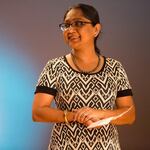
Subanshini Ganesan, appointed in January 2018 as Portland's Creative Laureate, is a dancer and choreographer, and director of a performance space that hosts hundreds of artists per year, New Expressive Works.
Courtesy of Subashini Ganesan
When Subashini Ganesan was named Portland’s Creative Laureate, she didn’t realize part of her role would be convincing the public her job exists.
“A friend of mine took me out for dinner,” Ganesan said, “and told the bartender all about it and the bartender looked over and said, ‘Is this a "Portlandia" episode?’ They seriously were looking for cameras!”
The position of Creative Laureate is very real and very important for connecting the city to the arts community.
The job has only been held by one other person, photographer Julie Keefe. Just as poets laureate are ambassadors for poetry and prose, Portland’s creative laureate is intended to champion the arts and broaden the city’s sense of its expressive self.
Ganesan is a performer, teacher and choreographer. She also serves a critical role, providing room to work for hundreds of independent artists and arts groups as the director of a nonprofit arts space New Expressive Works in Southeast Portland. (Ganesan picked up an award this week from the Regional Arts and Culture Council for "Using the Power of Space and Place.") Her first act as creative laureate? Founding Portland's first-ever South Asian Arts Festival.
Q&A with Subashini Ganesan
April Baer: What’s it like to wake up every morning and know you’re advocating for an entire city’s creative life?
Subashini Ganesan: I'm honored. I'm really honored. I find it a bit daunting at times. My real focus is in collaboration and creating relationships. So in this position I think I might have a way to connect helpers with those who need help.
Baer: In some ways, as you’ve been offering people a place at New Expressive Works, you have already been facilitating relationships. What have you learned at NEW about people’s needs — both artists and audiences?
Ganesan: So for those who've not been to the space, it's in a gray building. And a lot of art happens in the back 40, as I like to call it. We house about 200 independent performing artists. There's theatre, music, entire seasons happening right now — Third Angle New Music and their Studio Series, PDX Contemporary Ballet, Corrib Theatre, which is focused on Irish playwrights. So [it's] really a place that brings the richness of the independent performing arts world alive, on our own terms. That's one important thing I learned. Being an independent performing artist, sometimes we need to teach. Sometimes we need to make work. Sometimes we need a production crew. We don't follow this institutional calendar cycle all the time. The other thing I would say is we need venues that are neutral.
Baer: What does that mean to you?
Ganesan: The lobby and the artwork and the space does not immediately say, "Ah, this is the kind of art I'm going to see in this space."
Baer: There are no subtle cues about what kind of art is happening here and, by extension, what kind of audience is welcome here.
Ganesan: Yes! A lot of work is being done to diversify audiences. I believe the strength of NEW is that we have diverse audiences because the space is neutral. When [audiences] walk in to see a piano recital, the space looks like it is hosting a pianist. When they walk in to see my performances, it is a space that's presenting multicultural dance forms in a professional way. That's something I learned by watching and connecting with this extremely wide array of professional artists.
Baer: No one could accuse you of aiming small. You’re kicking off your tenure as creative laureate founding a new arts festival: Portland’s inaugural South Asian Arts Festival. Was this in the works before you took on the creative laureate role for the city?
Ganesan: It was going to be much smaller! I remember speaking with Erin Boburg at Portland Institute for Contemporary Art last February about my dream of having a weekend event in their new space. I was super attracted to their concrete floor they have. It's almost 11,000 square feet of bare floor. I want to have a festival which brings to visibility all the cultural art forms of my region that most people might not see, one of which is a floor art decoration form called rangoli, or kolam, or alpana that, in the early times, only women would draw on the floor with rice flour. It's something you do daily in front of your house [to] welcome the day, and welcome joy and prosperity to your home. It's something that can be super elaborate or really simple. I thought, "What a great place to have my community create an installation, in addition to music and food and art." It's just grown: RACC gave us a grant, Multnomah County Library said, "Why don't we have a two-month exhibition about South Asians concurrently?" It'll be a four-day festival, launching March 8.
